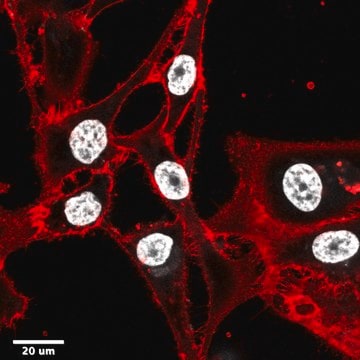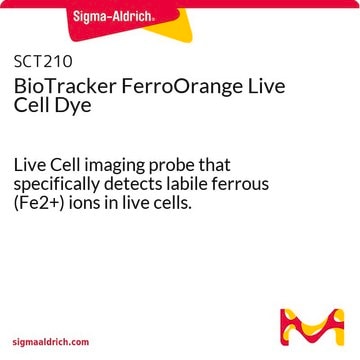SCT078
BioTracker Green HOCl-CM2 Live Cell Dye
Zaloguj sięWyświetlanie cen organizacyjnych i kontraktowych
About This Item
Kod UNSPSC:
12352207
NACRES:
NA.47
Polecane produkty
Próba
≥98% (HPLC)
Postać
lyophilized
masa cząsteczkowa
calculated mol wt 346.1
opakowanie
pkg of 1 mg
producent / nazwa handlowa
Millipore
warunki przechowywania
desiccated
protect from light
metody
cell based assay: suitable
kolor
yellow
fluorescencja
λex 417 nm; λem 485 nm
metoda wykrywania
fluorometric
Warunki transportu
ambient
temp. przechowywania
−20°C
Opis ogólny
Alzheimer′s disease (AD) is a progressive neurological disorder characterized by the presence of amyloid-beta (Aβ) plagues and neurofibrillary tangles. AD is associated with generation of excessive reactive oxygen species (ROS) in the brain, which cause oxidative stress and inflammation. ROS production involves elevated levels of hypochlorous acid (HOCl) and can serve as a potential biomarker of AD pathogenesis along with amyloid plagues.BioTracker Green HOCl-CM2 Live Cell Dye is a switchable coumarin-morpholine (CM) off-on fluorescence probe for the specific detection of HOCl produced and proximally localized with amyloid plaques. The nonfluorescent thioamide probe undergoes regioselective transformation to fluorescent amide probe in the presence of HOCl with high selectivity and sensitivity. This probe has excellent cellular uptake and can penetrate the blood-brain barrier (BBB) enabling detection, imaging, and quantification of HOCl in vitro and in vivo.
Spectral Properties
Absorbance: 417 nm
Emission: 485 nm
Reference:1. Samanta, S., & Govindaraju, T. (2019). Unambiguous detection of elevated levels of hypochlorous acid in double transgenic AD mouse brain. ACS chemical neuroscience, 10(12), 4847-4853.
Spectral Properties
Absorbance: 417 nm
Emission: 485 nm
Reference:1. Samanta, S., & Govindaraju, T. (2019). Unambiguous detection of elevated levels of hypochlorous acid in double transgenic AD mouse brain. ACS chemical neuroscience, 10(12), 4847-4853.
Zastosowanie
Purity ≥ 98% confirmed by HPLC. Identification confirmed by HNMR, LC-MS, and elemental analysis.
Cechy i korzyści
Off-on fluorescence probe for the specific detection of hypochlorous acid in Alheimer′s disease studies.
Postać fizyczna
Lyophilized. Yellow solid.
Przechowywanie i stabilność
Store at -20°C, desiccate and protect from light
Note: Centrifuge vial briefly to collect contents at bottom of vial before opening
Note: Centrifuge vial briefly to collect contents at bottom of vial before opening
Inne uwagi
Live cell fluorescent imaging
Oświadczenie o zrzeczeniu się odpowiedzialności
Unless otherwise stated in our catalog or other company documentation accompanying the product(s), our products are intended for research use only and are not to be used for any other purpose, which includes but is not limited to, unauthorized commercial uses, in vitro diagnostic uses, ex vivo or in vivo therapeutic uses or any type of consumption or application to humans or animals.
Kod klasy składowania
11 - Combustible Solids
Klasa zagrożenia wodnego (WGK)
WGK 3
Temperatura zapłonu (°F)
Not applicable
Temperatura zapłonu (°C)
Not applicable
Certyfikaty analizy (CoA)
Poszukaj Certyfikaty analizy (CoA), wpisując numer partii/serii produktów. Numery serii i partii można znaleźć na etykiecie produktu po słowach „seria” lub „partia”.
Masz już ten produkt?
Dokumenty związane z niedawno zakupionymi produktami zostały zamieszczone w Bibliotece dokumentów.
Sourav Samanta et al.
ACS chemical neuroscience, 10(12), 4847-4853 (2019-12-04)
Alzheimer's disease (AD) is one of the most prevalent forms of dementia. The current diagnosis methods based on the behavior and cognitive decline or imaging of core biomarkers, namely, amyloid-β (Aβ) plaques and neurofibrillary tangles (NFTs), in the brain offer
Nasz zespół naukowców ma doświadczenie we wszystkich obszarach badań, w tym w naukach przyrodniczych, materiałoznawstwie, syntezie chemicznej, chromatografii, analityce i wielu innych dziedzinach.
Skontaktuj się z zespołem ds. pomocy technicznej








